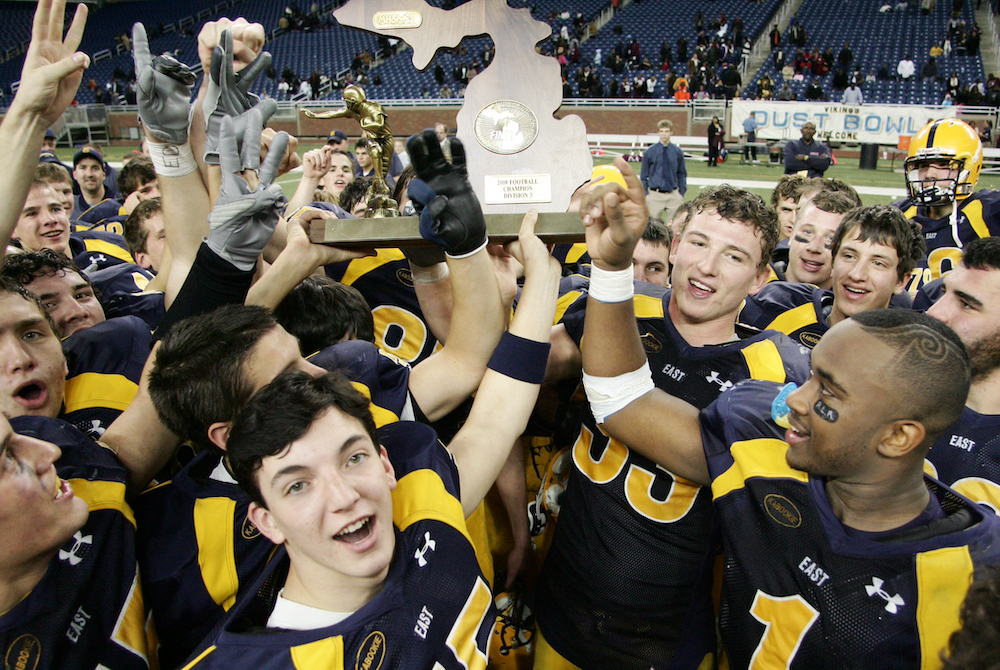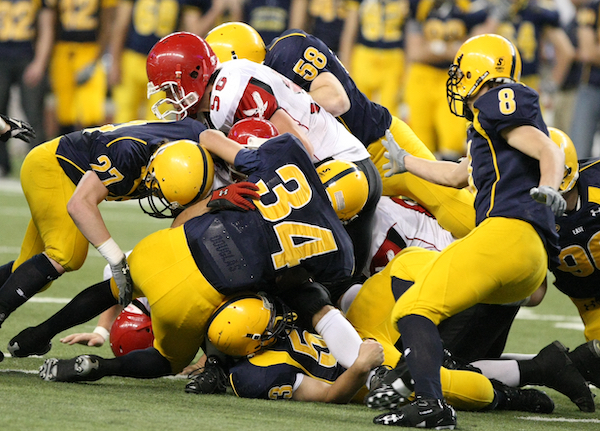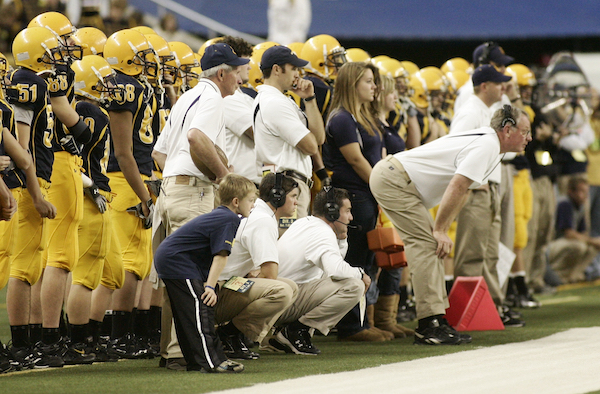
EGR 5-Year Title Run Remains Awe-Inspiring, Product of More Than Talent Alone
By
Steve Vedder
Special for MHSAA.com
November 25, 2022
It was Peter Stuursma's first year at East Grand Rapids and while the wolves weren't necessarily knocking at the door, they were definitely on the prowl.
The tradition-rich Pioneers football team had slumped to an uncharacteristic 3-6 record in Stuursma's first season as varsity head coach in 2000, and there were subtle signs a community used to winning was growing restless with the program's direction.
That's when Stuursma bumped into one of his players coming out of the weight room, and the two had a quick conversation which he clearly remembers 22 years later.
"It was this senior offensive lineman and all he said was, 'Don't worry about it Coach, it's not going to happen again. We got this,’" Stuursma said. "We had just gone 3-6, and I'm wondering how we're going to get this going and that they might get rid of me. You never underestimate what people can do."
East Grand Rapids, under legendary coach George Barcheski, had been the dominant football program in West Michigan with 28 winning seasons over 29 from 1970-99, and 38 victories in 39 games from 1993-95, along with Class B championships in 1976 and 1983. After Stuursma replaced the retiring Barcheski,, some in the community were expecting more of the same when it came to success.
Those fans never dreamed what they would see as the Pioneers promptly pieced together arguably the greatest decade-long stretch in Michigan high school football history – and without doubt one of the most incredible five-year runs of dominance.
Even that optimistic offensive lineman couldn't have imagined a remarkable 126-7 record over the next 11 years, a 40-3 MHSAA Tournament mark and seven Finals championships. Five of those titles (2006-10) came in a row, a feat accomplished just three times in the now 46-year history of the playoffs.
 The five straight championships were part of an amazing era that Stuursma and his players say has not diminished with time. They recall no single factor explained going 67-3 overall over those five seasons. There was talent, obviously, but coaching, tradition, confidence and strength of community all played vital parts. There were Thanksgiving practices attended by hundreds of former football alumni, dedicated fan support that included playing before more than 30,000 fans at least twice at Ford Field, and a program-wide attitude that, while some may call it a cliché, proved that success did indeed breed success.
The five straight championships were part of an amazing era that Stuursma and his players say has not diminished with time. They recall no single factor explained going 67-3 overall over those five seasons. There was talent, obviously, but coaching, tradition, confidence and strength of community all played vital parts. There were Thanksgiving practices attended by hundreds of former football alumni, dedicated fan support that included playing before more than 30,000 fans at least twice at Ford Field, and a program-wide attitude that, while some may call it a cliché, proved that success did indeed breed success.
"I'm in awe of the scope of things," said Stuursma, whose team used back-to-back Division 3 championships in 2002-03 as a springboard to later success. "Because we had won a couple times before it just started to feel normal. We had such support the community used to think Thanksgiving break ended at Ford Field."
EGR teams would find all kinds of ways to win during the five-year title stretch. The 2009 team, for instance, barreled through its first four playoff opponents by a combined score of 164-29 until a 24-21 win over Orchard Lake St. Mary’s in the Final. The 2010 team had to win three playoff games by eight points or fewer to finish off its perfect 14-0 record. And then there was the wild 46-39 five-overtime win over St. Mary's in the 2007 Final during which the Pioneers had to score on all five possessions in overtime to outlast the Eaglets.
While teams always seemed to find ways to get the victory, former players remember what it was like to be part of a seemingly endless tradition of success on the football field.
"One of the things that was so special about East Grand Rapids were the expectations," said Luke Glendening, a running back on the 2006 team who has gone on to a long NHL career with the Detroit Red Wings and Dallas Stars. "During the game I'd look around and see guys who had played here a long time ago. I viewed it as a privilege to have the opportunity to play before the alumni and community."
Quarterback Ryan Elble, who completed a combined 34 passes for 483 yards and seven touchdowns during the 2008 and 2009 Finals, also used the word "honored" to describe his high school experience.
"The culture was to win. Coach Stuursma made it fun, and it always seemed to take shape on the field," said Elble, who went on to play baseball at Miami (Ohio) "I think each team had different skill sets, but at the end of the day it was our culture and putting in the work to spend Thanksgiving weekend at Ford Field."
The players point to that winning culture over talent. Elble said he played with only one eventual Division I college player in linebacker/running back Trent Voss, who went on to Toledo. Nobody wins without talent, of course, but they point to many other factors as being just as critical. Because EGR coaches would always work juniors into the lineup, Stuursma said the program faced only one major rebuild, in 2007. That team wound up 13-1 and the second of those five straight champions.
 "We had some incredible players," said Stuursma, who left EGR in 2016 to lead Hope College to two Michigan Intercollegiate Athletic Association titles, three second-place finishes and a 46-15 overall record over his seven seasons. "We returned only two starters (in 2007), but we still had good guys who wanted to win."
"We had some incredible players," said Stuursma, who left EGR in 2016 to lead Hope College to two Michigan Intercollegiate Athletic Association titles, three second-place finishes and a 46-15 overall record over his seven seasons. "We returned only two starters (in 2007), but we still had good guys who wanted to win."
The players say the culture started with Barcheski and the program's tradition. As Hope College's coach, Stuursma said there’s a similar common thread among schools he sees on recruiting visits: a winning tradition that, in Stuursma's words "screams excellence," from every corner of the building. He sees it the minute he walks into some schools, and East Grand Rapids had the same culture before he arrived. The past players say it played a major part in their careers.
That tradition didn't start with the five straight titles, said former quarterback Kyle Cunningham, who played on the 2002-03 teams and went 46-0 over four years from his freshman to senior seasons. Those two championship teams’ most recognizable player was running back Kevin Grady, who still holds multiple MHSAA records including for career rush yardage and went on to play at University of Michigan.
"We worked hard and had a lot of pride," he said. "I remember watching film of earlier teams, and I remember hoping our team could stand up the same way."
While the players point to tradition and community, Ryan Blair, a tight end/defensive tackle on the 2006-08 champion clubs, said talent remained critical – but EGR was outmanned physically in some of those title games. That's when camaraderie and the confidence that someone was going to make a key play took over. The Pioneers' remarkable run was teeming with such plays.
"Certainly we were never one of the biggest teams there, we never had a big size advantage in any game," he said. "But we had this camaraderie on every team. We had guys who really liked playing with each other. When things got tight we stuck together, and we'd fight to the fourth quarter or beyond."
Despite the long odds of winning a single state title let alone repeating, Stuursma believes there could be a team one day which wins six straight. That team will have the same characteristics of those EGR teams – the talent, coaching, tradition and fortune of catching timely breaks – but it can be done, he said.
"Absolutely," Stuursma said. "The only record I can think of that won't be broken is Wayne Gretzky's (NHL) scoring record. It will take a lot, but records are made to be broken. I think high school football is on the upswing and there would have to be an emphasis on winning. You would have to have a good path to get there, but I can see someone getting six one day."
PHOTOS (Top) East Grand Rapids celebrates its third-straight Division 3 championship win in 2008. (Middle) Pioneers converge on an Orchard Lake St. Mary’s ball carrier during the 2007 five-overtime title decider. (Below) EGR coach Peter Stuursma, kneeling center, monitors the action during the 2010 championship game.

DeWitt Rewrites Finals Rushing Record Book in Completing Perfect Run
By
Scott DeCamp
Special for MHSAA.com
November 30, 2025
DETROIT – Traverse Moore had no idea about his record-setting day until the final moments of Sunday’s Division 3 Football Final.
“Honestly, I wasn’t worried about that. I was worried about getting the state championship win,” the shifty and speedy DeWitt senior quarterback said.
Moore and the Panthers left no doubt whatsoever. They ran into the history books.
On the strength of Moore’s Finals-record 397 rushing yards and four touchdowns, DeWitt rolled past Mount Pleasant, 54-20, in a battle of unbeatens at Ford Field. Moore’s effort shattered the record set in last year’s Division 6 Final by Jackson Lumen Christi’s Kadale Williams (314).
“We’ve been dreaming about it since fourth grade when we first started playing together. For this group of seniors to do that today, I couldn’t be happier,” said Moore, whose squad is the second from DeWitt to capture a Finals football title. The 2020 team won the first championship.
In DeWitt’s eighth championship game appearance, Moore scored three TDs in the opening quarter to tie a Finals record and help stake the Panthers to a 26-7 lead. The 6-foot, 195-pound Central Michigan University commit scored from 30 yards out barely two minutes into the contest, from 33 yards a little more than a minute later, and sprung free for a 74-yarder just past the midway point of the first quarter.
Moore’s fourth TD came on a 13-yard run barely three minutes into the second quarter. He had the Finals record for rushing yards early in the third quarter. He carried the ball 32 times in the game, good for 12.4 yards per attempt. Moore also completed 4 of 8 passes for 64 yards and a TD.
 As a team, DeWitt (14-0) rushed for a Finals-record 575 yards on 58 attempts (9.9 per carry). It surpassed the previous record of 549 rushing yards by Constantine in the 2004 Division 6 Final.
As a team, DeWitt (14-0) rushed for a Finals-record 575 yards on 58 attempts (9.9 per carry). It surpassed the previous record of 549 rushing yards by Constantine in the 2004 Division 6 Final.
Moore tipped his cap to DeWitt’s offensive line and tight ends, an all-senior unit comprised of Jackson Hildebrant at center, Sam VanZee and Luke Nolen at guards, Drew Rumsey and Landon Fitzpatrick at tackles, and Jacob Schorfhaar and Caleb Haman at tight ends.
“The guys up front have been special all year,” Moore said. “That’s a group of seniors that have been together since fourth grade – all of us have been together since fourth grade. They’ve been playing O-line since fourth grade, so that’s a special connection and they’re just workhorses, man.”
Sophomore Channing Ridley also reached the 100-yard plateau for DeWitt, finishing with 101 yards on 10 carries, including a 13-yard TD. Senior Jadon Bender caught a 35-yard TD pass from Moore, and junior Tyler Bashore closed out the Panthers’ scoring with a four-yard run. Bashore ended with 77 yards on 16 carries.
DeWitt piled up 219 rushing yards in the first quarter, 153 in the second, 73 in the third, and 130 in the fourth.
“In the offseason, we looked at what we had coming back,” said veteran DeWitt coach Rob Zimmerman, who completed his 27th season at the helm. “DeWitt’s probably known for being a team that throws the football around quite a bit. Last year we were physical and we threw a lot more, but with what we had coming back up front and the speed that we have, you can’t take away everything that we have.
“It’s a great combination with all the single-wing stuff that we do, which nobody else does, and so that’s an issue. But then we have the ability to run right at you and our counter game has been phenomenal for the last two years,” Zimmerman continued. “It’s a tough matchup, and then you add in the tempo, too, that we show quite a bit. I think we’re faster (in that tempo) than anybody else is as far as running plays. Put all of those things together, it’s pretty tough to stop.”
Mount Pleasant (13-1) got on the board midway through the first quarter on a 31-yard TD pass from junior Xavier Creguer to senior Riley Olson. Creguer added a four-yard scoring run with 12 seconds remaining in the first half, but the Oilers were still facing a 40-14 deficit headed into the halftime break.
Creguer joined Moore in the record books with his 91-yard TD run in the third quarter – longest in Finals history, surpassing 90-yard scoring runs by Edwardsburg’s Nick Bradley (2017) and Farmington Hills Harrison’s Nick Williams (1994).
It was an uphill battle for Mount Pleasant, which made its second Finals appearance and still seeks its first championship.
 “I wonder if a little bit of the bright lights got to us to start with. We made a few mistakes from the start … . Just a few, little things that we’d like to have back,” Mount Pleasant coach Jason McIntyre.
“I wonder if a little bit of the bright lights got to us to start with. We made a few mistakes from the start … . Just a few, little things that we’d like to have back,” Mount Pleasant coach Jason McIntyre.
“That’s a tremendous DeWitt team. It would have been really difficult to hang up the middle, but I think you saw what we could have done maybe if we would have been able to start a little fresher, a little cleaner. … Their offense is super difficult to defend. I thought we were well-prepared in terms of alignment, but the speed in which they do it and obviously No. 2’s (Traverse Moore) a really good player.”
Creguer finished with 162 rushing yards on 12 carries. He also threw for 66 yards.
Senior William Garcia led all defenders with 11 tackles for Mount Pleasant, while Olson notched 10 stops. Senior Lucas Brandell recorded a team-high six tackles for DeWitt.
DeWitt lost in last year’s Semifinal to eventual champion Zeeland West, 32-20. That defeat lingered with the Panthers and fueled them for this season’s run to glory.
“I mean, that stung. Last year stung. It hurt,” DeWitt senior Miller Wing said. “But when winter lifts rolled around, 5:45 in the morning, that’s the reason for it. It’s just staying together as a team. We’re so close.”
DeWitt has been a perennial contender in Division 3. The Panthers have advanced to the Semifinals or further seven of the last eight seasons.
According to Zimmerman, it’s all about the culture, establishing expectations, and putting in the work.
“The older kids have always helped our younger guys to understand the expectations within the program, and I think that’s a big part of why we’re where we’re at as a program,” Zimmerman said. “These guys want to be the next dude, and they work to get there.
“Ton of similarities (between the two championship teams) from a toughness standpoint, leadership standpoint, work ethic. I mean, these guys put in an unbelievable amount of time in the offseason to get where they’re at. This class, from sophomore (season on up), they’re 35-1 as a class, so it’s a pretty good group.”
PHOTOS (Top) DeWitt’s Sam VanZee (54) hoists teammate Traverse Moore into the air in the end zone Sunday. (Middle) Landon Kurncz (13) attempts to surge ahead with Mount Pleasant’s Keagan Wernette-Beals (11) and another defender wrapping him up. (Below) The Oilers’ Xavier Creguer prepares to take on a DeWitt defender.

